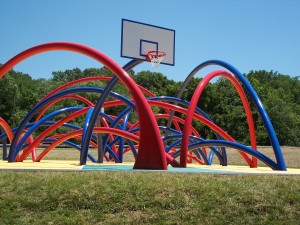Monumental, public works of art have, of course, been created since the dawn of time. Think Stonehenge. Today we see numerous works of public art created out of every conceivable type of material: steel, plastic, stone, wood and various kinds of recycled materials. Those of us who work with metal can especially appreciate the impressive work of those artists who work with metal. Those of us who curve steel enjoy collaborating with these artists to realize their visions.
Artists who work with metal often can self-perform much of the hands-on creation of art. Typically they can cut, bend, and weld steel in their own studios. But when it comes to curving heavier sections of metal, they often turn to Benders/Rollers who specialize in rolling all the metal sections as well as curving sheet and plate. Although bending metal for art is probably not a huge market for any Bender/Roller, almost all the Bender/Rollers do some work for artists.
Artists sometimes begin with a design that has been commissioned by a municipality, museum, school, hospital or individual (to name just a few potential patrons of the arts). More and more, cities and towns have mandated that public works of art be commissioned as part of a real estate development. Museums develop outdoor sculpture gardens and individuals grace their property with metal sculptures.
Certain artists gravitate toward incorporating curved steel in their sculptures. They visit the shops of Bender/Rollers with their designs drawn on paper or expressed in miniature models. Sometimes they study the scrap bins for material useful for their craft. Even steel slugs that are produced when punching holes in metal have been welded together to create art.
The sculpture “Free Basket” by two Cuban artists was commissioned by the Indianapolis Museum of Art. It incorporates basketball backboards and steel pipe curved to suggest the trajectory of a basketball across the court. The artists originally wanted to use 12 x 4 rectangular tubing for the arches. One of our project managers suggested using 8in Schedule 40 pipe with a diameter of 8.625, much closer to the actual 9.39in diameter of a basketball. The artists accepted the suggestion and changed the rectangular tubing to round pipe. The technical and aesthetic collaboration of the artists with the Bender/Roller has created playful, surprising work of art enjoyed by all who visit the museum grounds.








